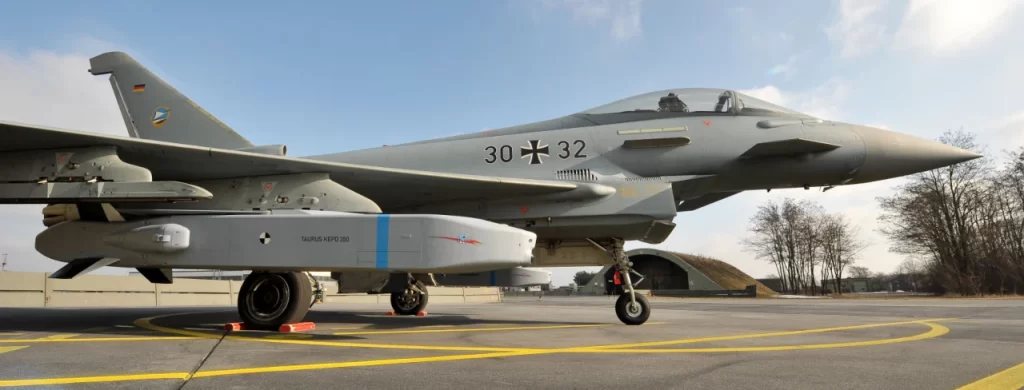Ukraine has asked Germany for TAURUS cruise missiles in a formal request, as the German newsweekly Spiegel reported. The German Ministry of Defence has acknowledged receiving the request from Ukraine.
According to the publication, the German Ministry of Defence spokeswoman did not provide additional information regarding this request, including the number of TAURUS cruise missiles Kyiv expects to receive.
According to the Frankfurter Allgemeine Sonntagszeitung, the Ukrainian president, Volodymyr Zelensky, and the German chancellor, Olaf Scholz, discussed the shipment of missiles at the start of May.
Airborne TAURUS cruise missiles will enable long-range attacks on Russian military infrastructure.
Previously, Germany promised to transfer German TAURUS missiles to the Ukrainian Defence Forces.
Roderick Kiesewetter, a Bundestag member, spoke in favour of supplying this weapon. He is one of the most influential German lawmakers in the areas of security and defence, as well as one of those who consistently supports Ukraine.
He emphasised that the TAURUS cruise missiles with a range of up to 500 kilometres could be a “very valuable contribution from Germany” and that “there should be no more red lines” in this instance. Kiesewetter emphasised that employing these guided missiles in Ukraine would make much more sense than storing them in Germany.
Spiegel also reported that German Defence Minister Boris Pistorius respectfully responded to Kiesewetter’s proposal. He also stated that Germany should support Ukraine with all weapons systems permitted by international law that are required to win this conflict and that the allies can provide.
TAURUS cruise missile
Subsonic air-to-surface cruise missile TAURUS KEPD 350 is quite similar to the British Storm Shadow missile in terms of its tactical and technical characteristics, but its delivery accuracy is slightly lower, with a circular error probability (CEP) of three metres. However, it can approach the target from a very low altitude of only 30 metres.
Externally, the TAURUS differs from the Storm Shadow in that it resembles a winged kayak rather than a missile. Its fuselage has a distinctively rectangular cross-section and boat-shaped bow structures. The aft section has a P8300-15 turbojet engine with a thrust of 6.67 kN and two side air intakes. The intakes’ S-shaped channels contribute to reducing radar visibility. In addition, the missile can fool adversary air defence systems by deploying decoy reflectors and infrared traps when penetrating their defences.
Daimler-Benz Aerospace (Germany) and Bofors Dynamics AD (Sweden) began developing the TAURUS missile in 1994, and at first, they examined several different warhead options. The engineers settled on the tandem-shaped charge warhead MEPHISTO because of its ability to break through layers of reinforced concrete.
The tandem-type warhead consists of two consecutive charges: a 95-kilogram front charge and a 399-kilogram penetrating charge in the missile’s fuselage. The programmable detonator can determine the number of breached barriers and issue the order to detonate the main warhead. The missile’s trajectory depends on the sort of target. The attack on shelters and command posts will require low-altitude flight followed by lofting and steep dives. The missile will approach from a high altitude and then dive towards targets located deep within hostile territory poorly protected by air defence systems. And for tunnel-like objects, they will approach at a low altitude and descend to an exceedingly low altitude around the target.

The missile’s electronic “brain” is located in its nose compartment, which houses the combined Tri-Tec guidance system. It consists of a LITEF inertial system with laser gyroscopes, a GPS receiver, a terrain-referenced navigation (TRN) channel with a radio altimeter, image-based navigation (IBN) optical-electronic correction module, and a thermal imaging terminal guidance system. The onboard software, ATR, can select the aiming point autonomously by storing target image templates acquired from all angles in its database, enabling target recognition by combat algorithms.
Using the Joint Mission Planning System (JMPS), the TAURUS KEPD 350 missile’s mission is planned in two distinct phases. First, information is gathered from various sources regarding potential targets, their locations, and the enemy’s air defence system composition. The flight mission is developed using portable Taurus Communication Centre (TCC) terminals. The operator constructs a model of the target area and multiple missile flight trajectories. The route is selected based on terrain, target characteristics, navigation system capabilities, and the location of the enemy’s air defence system. The optimal flight mission is selected from the generated options and fed into the memory of the TAURUS KEPD 350 missile.
The TAURUS KEPD 350 missile is currently carried by tactical fighters such as the Typhoon, Tornado, JAS 39 Gripen (Sweden), and F/A-18 Hornet (Spain) in Europe. In April 2018, British Tornado aircraft armed with TAURUS KEPD 350 missiles attacked ISIS positions in Syria. The Ukrainian Air Force still employs aircraft manufactured by the Soviet Union that are equipped with launchers for appropriate-weight munitions, including the Su-24M. NATO specialists will probably be involved in formulating flight missions for the guided missiles.
